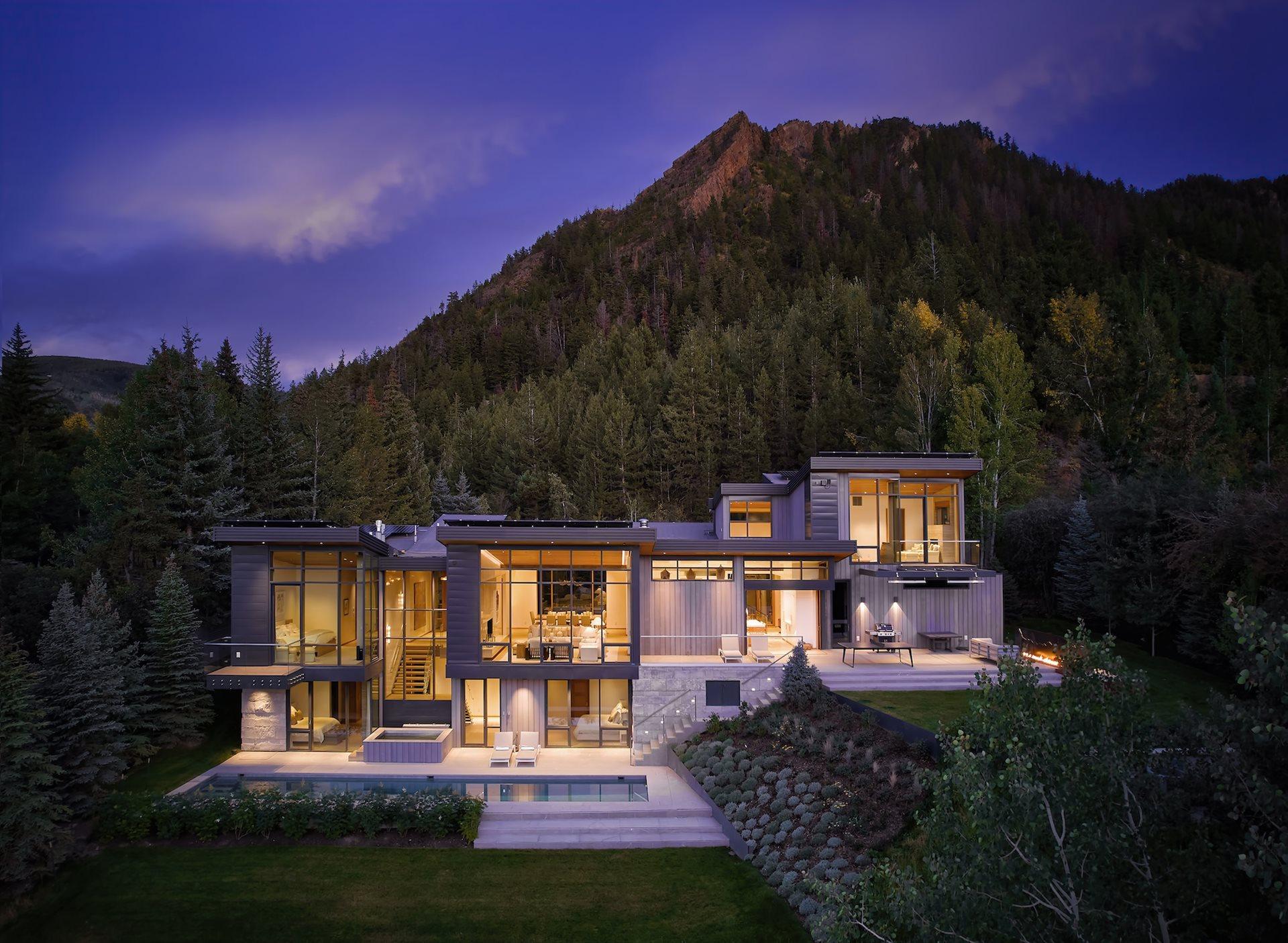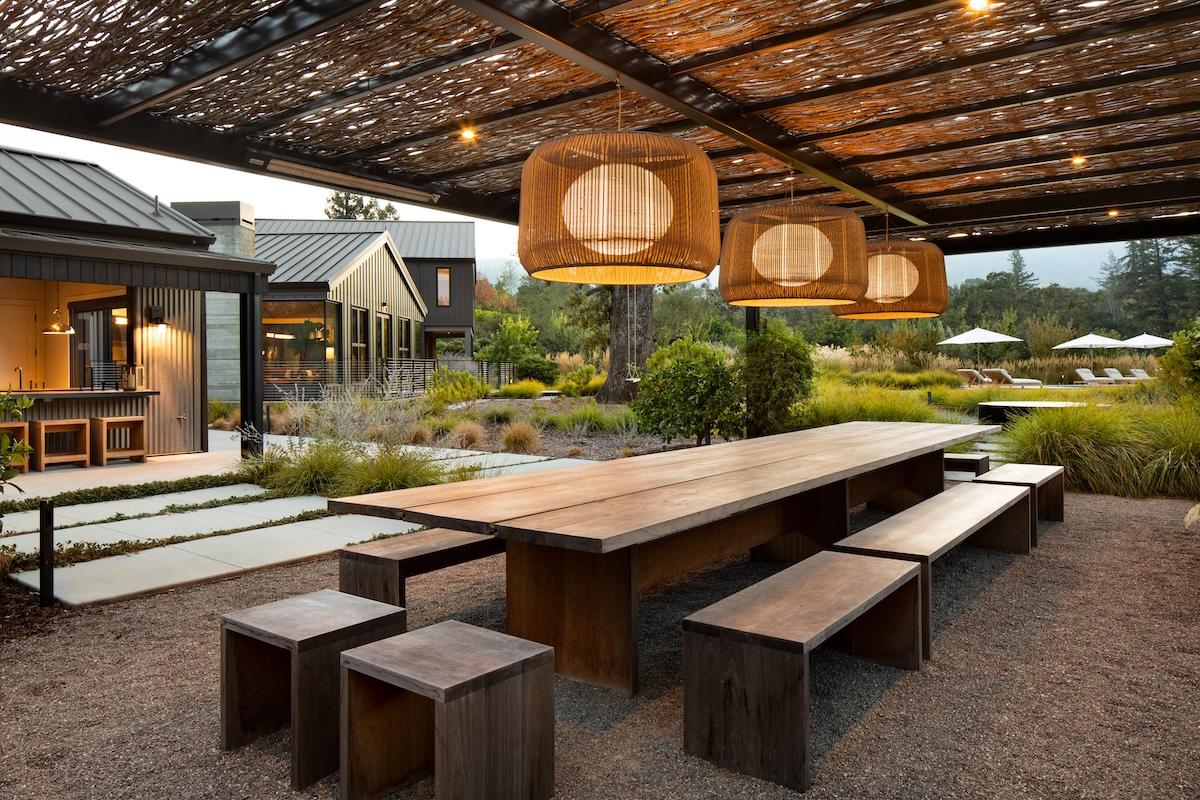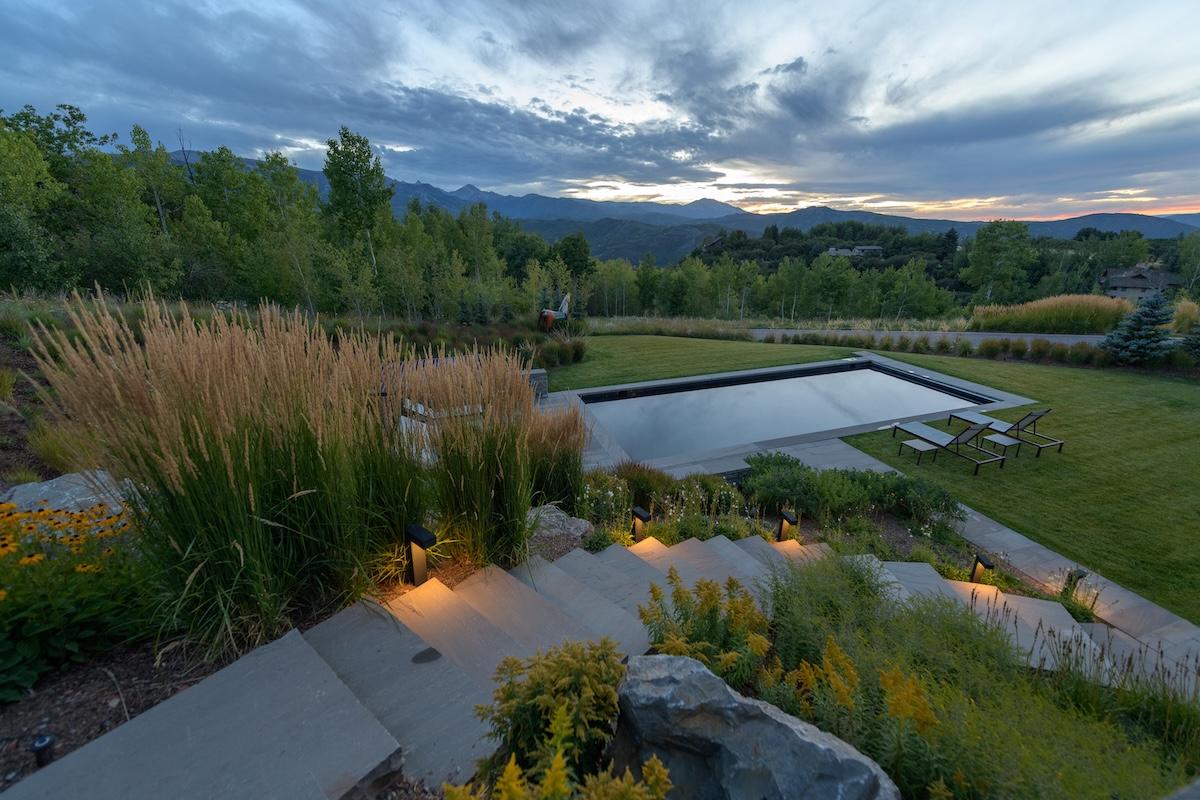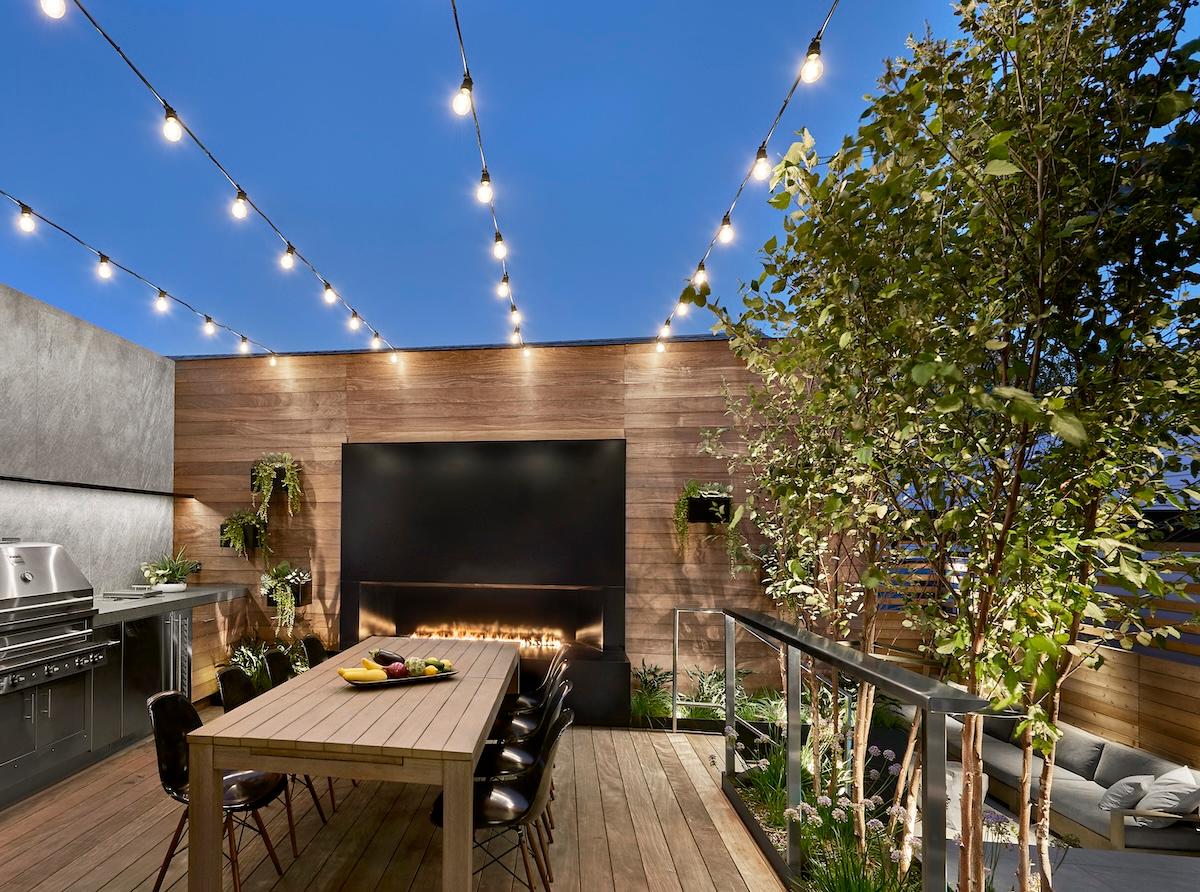
Ask any architect or designer and they will tell you: overlooking the indoor lighting plan is simply unthinkable. Thoughtfully designed lighting elevates the ambiance, aesthetics, and function of any space. Yet when it comes to outdoor design, lighting is frequently considered last – if at all – despite being an essential component.
As part of our Design Dialogues series, we sat down with Gyles Thornely, Co-Founder at Connect One Design, Diana Mesh, Regional Sales Manager, NY at Selux and Nick Surges, Vice President at Night Light, to explore the strategic planning, material quality, and environmental considerations that go into great outdoor lighting while also looking at what the future might hold in this rapidly-evolving sector.
Beyond the nuts-and-bolts of safety and wayfinding, our panel shared how well-executed outdoor lighting enhances curb appeal, extends outdoor enjoyment, and fosters connection with nature and each other through illuminated entertainment and relaxation.

Enter the Zone
The most aesthetically pleasing and efficient outdoor lighting plans rely upon zoning: a pragmatic approach to selection and placement of fixtures within a space.
Similar to irrigation, outdoor lighting can be zoned into different areas. Smaller spaces might require fewer zones with multi-functional fixtures, while larger estates need careful planning to power gates, signs, and other features. Whether designing for a compact urban &ldquot;postage stamp&rdquot; lot or a sprawling rural ranch, the principle of less is more remains paramount.
Echoing this, Gyles observes “from a Landscape Architects perspective I always think of irrigation design and lighting design as being pretty similar. You can really over-irrigate and unnecessarily waste a lot of water. The same goes for lighting. If you don't really plan it out you're just plopping down fixtures.”
For example, the rules governing threshold points—be it a grand gate entrance or the immediate vicinity of a home's front door—are fundamentally consistent. The primary distinction lies in the potential for multi-functionality at a smaller, urban scale. Instead of deploying a redundant array of step lights, wall sconces, and recessed ceiling fixtures at an entry, a more refined approach could determine that ceiling-mounted cans alone might effectively illuminate both the doorway and adjacent stairs.
During the discovery phase, it's crucial to understand clients’ lighting preferences. Our panel advises starting with the bare minimum and then slowly building out, knowing that more can always be added later. It’s simpler and more cost-effective to add layers of light than to subtract them. By starting minimally, designers ensure a thoughtful, layered illumination scheme that reflects their clients’ lifestyles without sacrificing aesthetics. Summing up this philosophy, Nick states: “If everything is lit, nothing's lit.”

Thinking Beyond the ‘Bounce’
Every outdoor lighting plan is built upon safety and code compliance, often including the National Electrical Code (NEC) for safety, the International Energy Conservation Code (IECC) and ASHRAE 90.1 for energy efficiency, and local ordinances. In addition to providing adequate illumination for egress points, steps, and changes in elevation, designers must also take larger environmental considerations like dark sky initiatives into their process.
Some core strategies for balancing code compliance and aesthetics include:
- Put Safety First: Illuminate critical, code-required areas like paths and steps first.
- Paint with Light: Utilize ambient, task, and accent lighting to create layered depth and drama.
- Be Selective: Choose fixtures with proper shielding (like full cutoff), appropriate beam spreads, and warmer color temperatures (2700K-3000K) to minimize glare and light spill (often mandated by dark sky regulations).
- Take Control: Occupancy sensors, daylight-responsive controls, timers, and dimmers can reduce energy consumption while delivering flexible lighting scenarios.
- Stay Connected: Close collaboration with architects and other professionals from the outset of a project will set the foundation for a successful lighting plan.
“The process is quite code driven,” explains Gyles “but (my advice would be) try not to overdo the lighting. A very special sprinkle of lighting in very targeted places is what I suggest to my clients. We're not trying to illuminate the world.”
Compared to interior lighting treatments, outdoor lighting presents a unique challenge due to the relative absence of reflective surfaces. Diana explains “What's very tough about outdoor lighting is that you don't have the reflectance and the bounce light that you would have inside an interior space. Meaning if you light a wall inside a space, it could help light the entire room. Outdoor lighting is trickier. The light travels and lands a little differently and the contrast issues are very, very different.”
The key to creating well-designed outdoor lighting lies not in focusing on the physical location of the fixture, but in anticipating where the light emanating from it will appear. A fixture discreetly positioned high in a tree, for instance, remains unseen until its illumination reaches the ground below. This concept is paramount outdoors because, without many reflective surfaces, light travels and concludes its journey precisely where directed.
.JPG)
Quality Materials, Responsible Practices
Investing in durable, high-quality materials like cast aluminum, brass, or copper ensures longevity as does strategic installation techniques. “Equipment really needs to be robust for outdoor environments. I found this out the hard way with my own house,” warns Diana. “Exterior lighting can be expensive because it has to withstand all the elements. It also must put up with a weed whacker coming by, snowstorms, and super-hot temperatures in the summer that might melt the LED board. It's money well spent to buy quality. I would say buy less equipment and buy high quality.”
Without proper installation, outdoor lighting fixtures will be quite literally on shaky ground. Nick explains “When it comes to choosing the right fixtures, the last thing I'll add is: mount them properly. Path lights and up lights, especially in cold areas, want to be ejected from the ground. The Earth does not want them in there and it will start to push them out almost immediately.” Like shrubs, grasses and flowers, any outdoor lighting which goes into the earth needs to be planted, not placed.
While the aesthetic dangers of over-lighting could be considered simply a matter of taste, our panelists’ warnings about over-lighting the outdoors extend far beyond the aesthetic. Over-lighting (or even using unhealthy colors of light) can create far reaching, negative effects for pollinators, migratory birds, sea turtles, and even mammals - humans included. “Why do we care about night skies?” asks Gyles. “There are probably some people who don't care, thinking ‘I live in a city, I've never seen the stars. Why should I care?’ I think it does matter to us as a society... We owe it to ourselves and fellow inhabitants of this planet to not pollute the night sky.”
DarkSky, an organization with a presence in over 70 countries offers a collection of simple actions to help reduce light pollution, including:
- Reduce & Remove: Get rid of unnecessary light sources and replace old fixtures with DarkSky approved ones
- Spread the Word: Sometimes the worst over-lighters don’t even know it’s a problem. DarkSky offers a guide to sensitively broaching the subject with neighbors.
- Share Data: Mobile apps and even the naked eye are all tools for measuring light in your area.
A Brighter Future
With rapidly evolving trends and technologies shaping how we utilize and enhance our external environments, the Luminaries foresee significant shifts on the outdoor lighting horizon: from AI-driven intelligent lighting to the blurring of outdoor and indoor entertaining, to the reclamation of public spaces and beyond.
Nick observes, "I think the outdoor kitchen revolution is in full swing right now.” As this revolution continues to grow, the demand for professional lighting plans for outdoor kitchens is set to grow with it. Strategic layering of task lighting for cooking and preparation, ambient lighting for comfortable dining and socializing, and accent lighting to highlight architectural features or landscaping are all key ingredients. A well-considered approach ensures safety, extends usability long after sunset, and elevates the entire outdoor living experience—potentially boosting property value. “Clients are definitely paying more attention to the outdoor kitchen space and seeking to use that as an extension of their home,” he adds.
Tomorrow's outdoor kitchens will likely see even more integration of smart technologies. Current trends already point towards responsive lighting systems, leveraging AI for usage patterns and automated adjustments for efficiency and convenience. Gyles envisions AI playing a crucial role throughout the outdoor lighting sector. "There's a lot of AI technology going into soil sensors and I'm excited to see how that will work. I think the same is reflected in the lighting industry. I hope that AI can help us understand usage patterns, so if someone's walking through a plaza, it's a bit like when you go into a grocery store late at night and the lights turn on for the milk section or the refrigerated section. It is going to be similar to that but never compromising safety.” Expect to see smart lighting that seamlessly adapts to different activities, from vibrant task lighting during meal prep to a softer, warmer glow for post-dinner relaxation.
Diana noted a growing trend in the commercial sector: the reclamation of underutilized urban spaces. "We're seeing more companies lighting their roof decks, or maybe the top of their garage, turning these into outdoor spaces. And we're also seeing that in cities a lot of abandoned spaces like elevated railways or highways are being reclaimed as parks. I think that's come about because of the success of The High Line in New York City. Everybody discovered it's nice to have these outdoor spaces. So, the challenge now is: how do we make them safe and enticing environments that people want to be in?” While the challenges are plentiful, one thing is certain: versatile and adaptable lighting solutions hold the key.
Whatever the size and scope of a project, a well-executed outdoor lighting scheme contains immense potential to enhance our well-being, enjoyment, safety, and even property values. With careful planning from the very start, the selection of quality materials, and by taking a less-is-more approach, the future of outdoor lighting isn't bright—it's brilliant.

The Luminaries
Gyles Thornely – Connect One
Born and educated in the UK, Gyles Thornely brings over 15 years of international experience in landscape architecture and land planning. After earning his degree in Landscape Architecture from Heriot-Watt University, he spent 15 years at two globally recognized design firms, earning four awards and contributing to many successful projects. Leveraging this extensive background, Gyles co-founded Connect One Design, offering clients his comprehensive understanding of coordinating, communicating, and managing complex public and private sector projects.
Diana Mesh – Selux
With over 30 years in lighting, Diana Mesh began her career as a designer with FMS and CBBLD before founding her own practice. She later held VP roles at a global manufacturer and LiteLab Corporation and in 2009, co-founded Light Abilities, an NYC sales agency. Diana now serves as Selux’s Specification Sales Manager for New York City. Her diverse background offers unique insight into specifier needs. A native New Yorker, she also teaches lighting design at Parsons, FIT, and NYSID.
Nick Surges – Night Light
Beginning his tenure at Night Light in 2001, Nick Surges advanced from digging trenches to leadership in the service department—all while pursuing his higher education. After gaining further operational experience elsewhere, he returned to Night Light in 2014 as Production Manager, then General Manager in 2016, where he motivated teams and contributed as a designer. Today, Nick is co-owner and Vice President.

